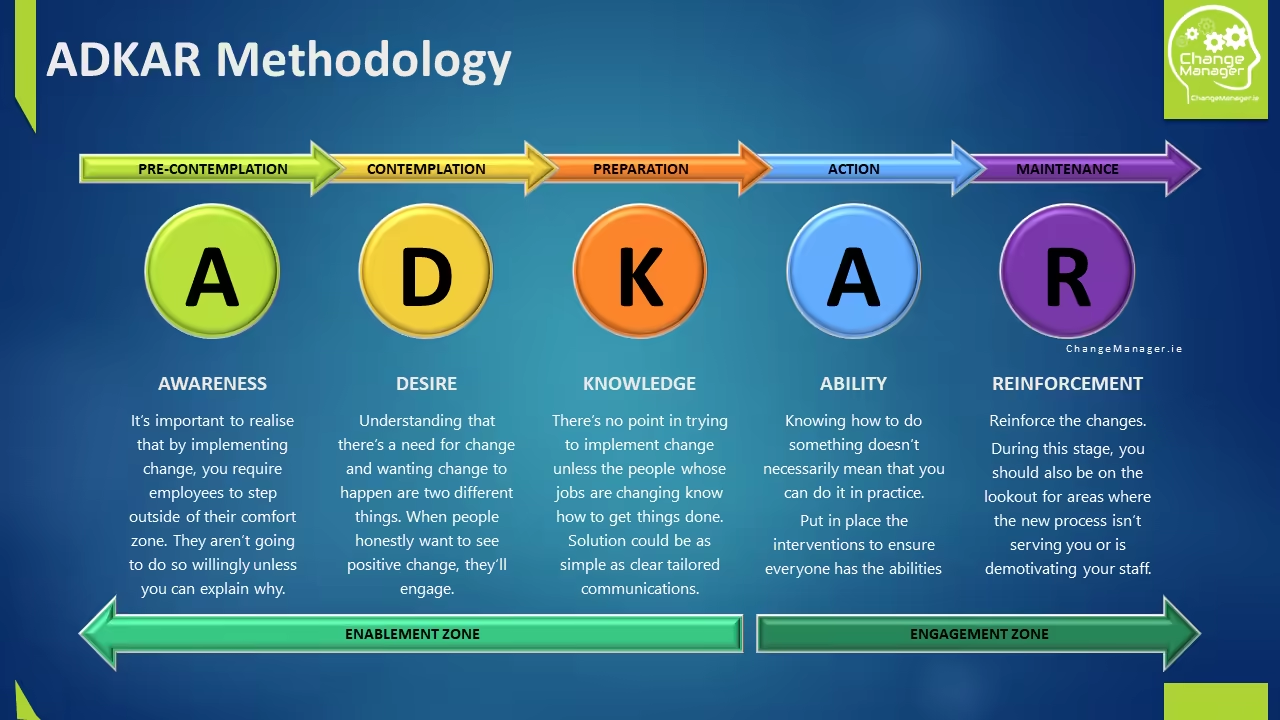Change is often necessary and important so that organizations remain relevant. While an organization’s executives may recognize the need for change, employees may be resistant since change can be hard and uncomfortable (Pearson 2021). Change is a complex and difficult process and it is inevitable. The most commonly cited reason for project failure is problems with the people side of change. Yet organizations often invest more in the technical side of change than in leading impacted people through times of change.
The first step in managing any type of organizational change is understanding how to manage the change that a single individual is experiencing (Prosci 2020). Driving successful change in individuals and organizations requires new thinking, new models for change, and new tools. The Prosci ADKAR Model is proven to help organizations achieve the greatest benefits from their change initiatives.
What is the ADKAR Model?
Created by Jeff Hiatt, the ADKAR change model has been proven to help individuals understand and accept change so that organizations can successfully innovate and become more efficient. The ADKAR change management model is based on the analysis of hundreds of successful and unsuccessful organizational changes over many years.
The ADKAR change model is based on the following building blocks:
A: Awareness. Make employees aware of the change.
D: Desire. Instill a desire to change.
K: Knowledge. Teach employees how to make the change.
A: Ability. Transform knowledge into the ability to make the change.
R: Reinforcement. Make the change permanent by reinforcing new methods.
Let us explore these five building blocks in more detail to help you understand how to implement the ADKAR model and facilitate individual and organizational change. The successful implementation of ADKAR depends on individuals having a clear understanding of what the changes are, why the changes are coming, and how the changes will affect them.
Awareness
The first step to any change is generating awareness for change. Building awareness as defined within ADKAR means sharing both the nature of the change and answering why this change is necessary. It means clearly explaining the business drivers or opportunities that have resulted in the need for change. It also means addressing why a change is needed now and explaining the risk of not changing.
Desire
Next, change practitioners must kindle a desire for change in employees. That is, they should influence individuals. Ultimately, the individual must choose to willingly support that change. Many practitioners say that desire is the most difficult of the five building blocks to achieve. Desire is difficult because it is ultimately a personal decision that is not under our direct control. While there are certainly ways to try and influence a person's decision to embrace a change, in the end, individuals must make this decision themselves. As with awareness, desire is only achieved when the individual decided to be part of the organizational change.
Tactics for Building Desire:
- Active and visible primary sponsor
- Strong sponsorship coalition
- Personal engagement by coaches
- Proactive management of resistance
- Strong employee involvement in creating the needed solution
- Incentive programs aligned with the change
Knowledge
Unless workers have the skills, knowledge, tools, and processes to change, they will not make progress. Effective change management means acquiring the knowledge to change and the knowledge to perform after the change.
Ability
Ability translates knowledge into action. In this stage, employees must turn their learning into practical application, via training, coaching, and support. While knowledge and ability can seem similar, there can be a very large gap between the two. While someone can gain knowledge about a new skill (the tools needed, the process, the proper technique), it may take much longer for this knowledge to translate into ability in terms of performance.
Reinforcement
Finally, change must be sustained. Reinforcement is critical and can include recognition and rewards, as well as internal satisfaction. Most organizations make a significant investment in helping people build awareness, desire, knowledge, and ability to make a change successfully. But without understanding and proactively planning to reinforce a change after it has happened, you run the risk of that investment being wasted and the expected results from the change not fully being realized.
Effective change management is difficult, which is why the ADKAR framework is so valuable.
Advantages of Using the ADKAR Model
There are plenty of benefits to using the ADKAR model:
- It provides a practical approach to change management. Some change frameworks merely describe group psychology or organizational change. These theoretical approaches can be useful, but they are difficult to apply directly.
- It is an out-of-the-box solution. Businesses should not have to reinvent the wheel. This makes ADKAR an excellent choice for companies that want ready-made recipes for change.
- It has been extensively field-tested. ADKAR has been around for a while. Also, it is one of the most popular and widely used change models, a testament to its success.
Related: The job characteristic model: everything you need to know
When Not to Use the ADKAR Model
It is difficult to find fault with the ADKAR model, given the benefits mentioned above. However, there are situations when an organization may want to consider other change management frameworks. Because the ADKAR model offers a very prescriptive approach to change management, it may not be useful for every business.
For example, an organization may want to explore other options when they
- Want deeper knowledge of change management? As mentioned ADKAR comes ready-made. This can be beneficial if you want something you can apply quickly. But it can be a drawback if your business wants to gain a deeper understanding of the field.
- Have a different value system or culture. Some businesses may simply be a cultural mismatch with the ADKAR Model. In that case, it would only make sense to look at different change models.
